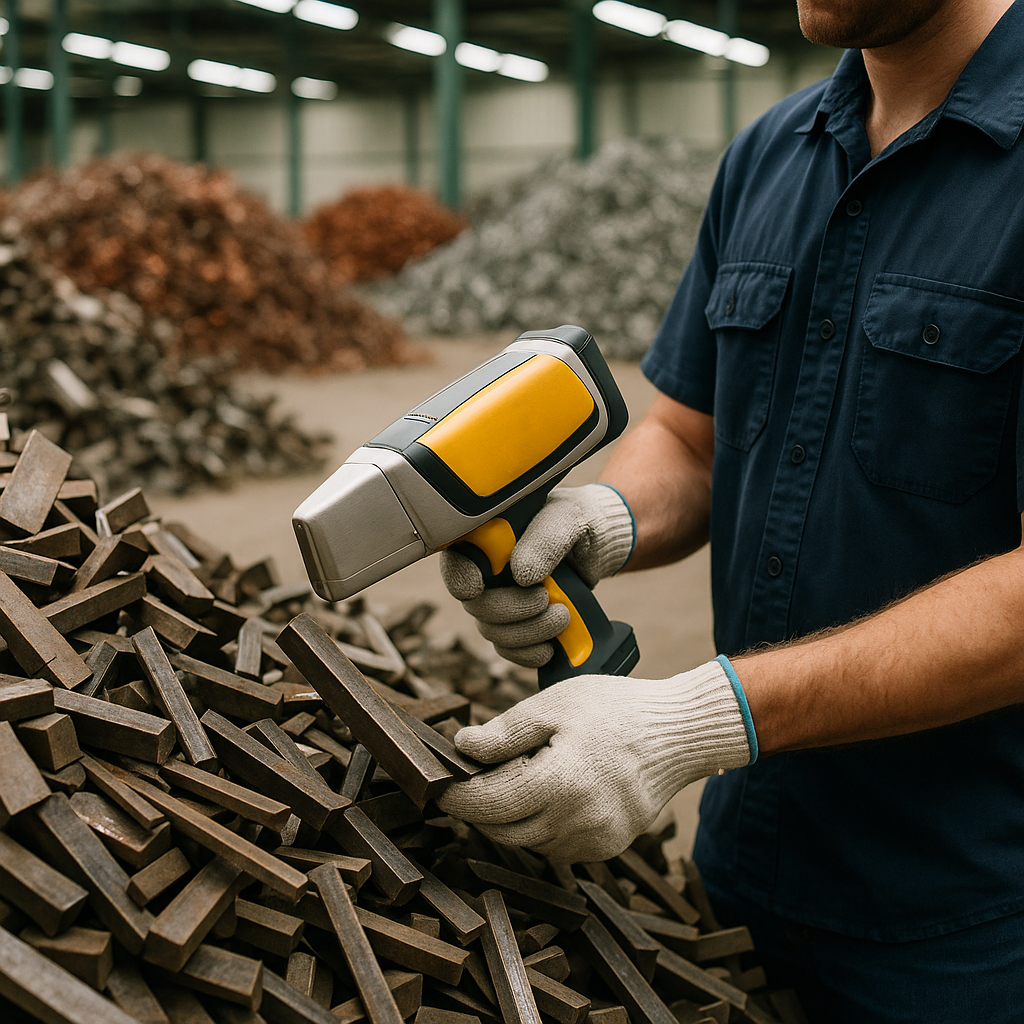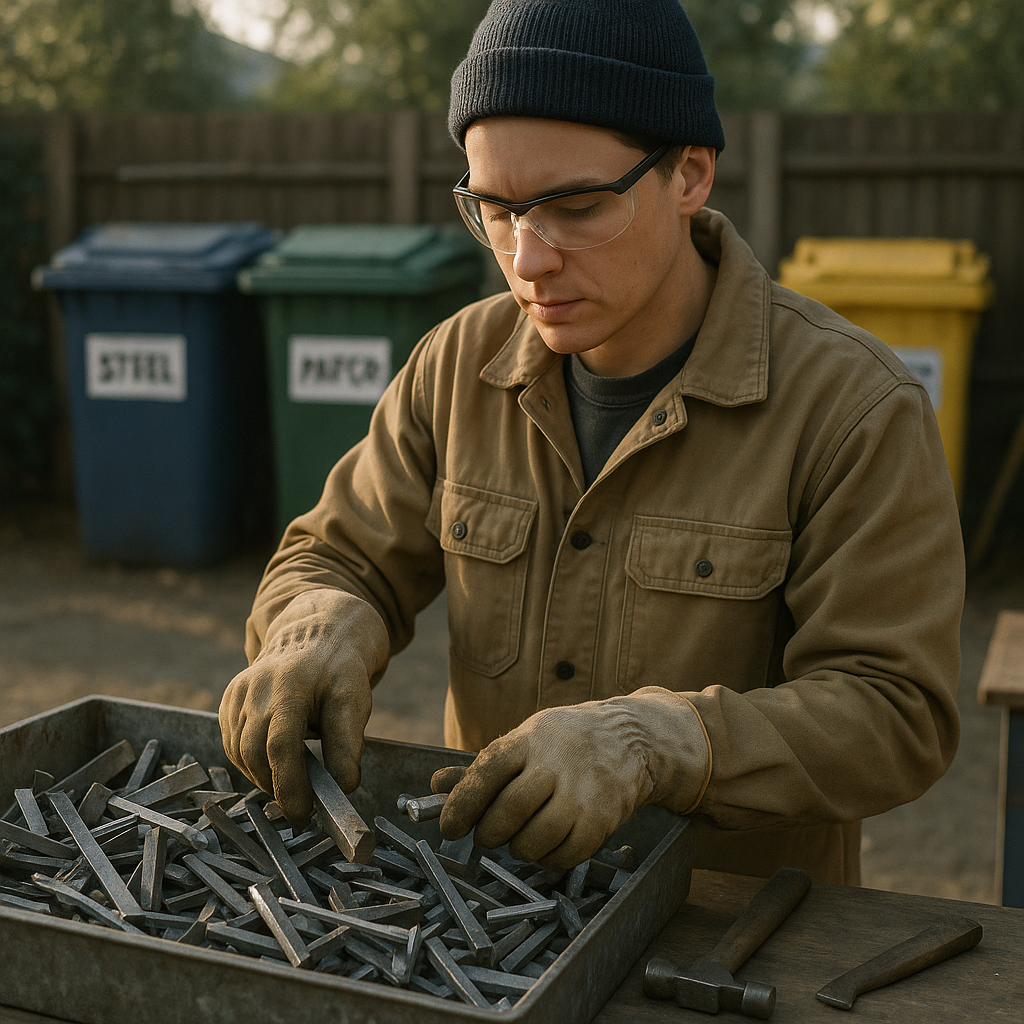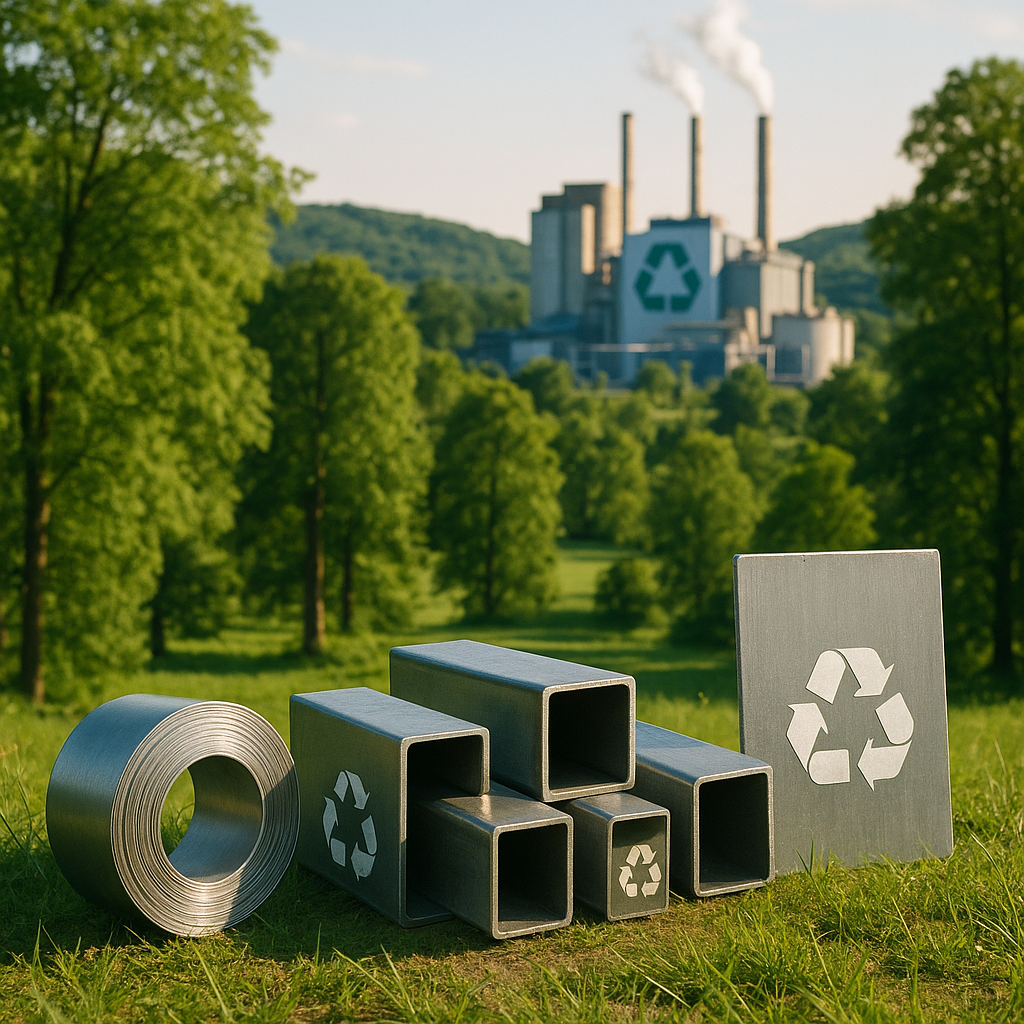5901 Botham Jean Blvd, Dallas, TX 75215
Learn the Process for Preparing Steel for Recycling
October 7, 2025Steel recycling is one of the most successful sustainability initiatives in modern industry, with over 60% of all steel being recycled annually in North America since 1970. This impressive recycling rate conserves natural resources and reduces energy consumption by 75% compared to producing steel from raw materials.
Steel’s unique properties make it infinitely recyclable without losing quality or strength, making the preparation for recycling highly valuable for both the economy and environment. By diverting steel from landfills, the demand for extracting virgin iron ore decreases, while simultaneously creating jobs and reducing greenhouse gas emissions.
Preparing steel for recycling requires careful handling to maximize its value and ensure efficient processing. The process transforms end-of-life steel products into valuable raw materials for manufacturing new goods, completing a sustainable cycle that exemplifies the circular economy in action.
How Do You Sort and Identify Different Types of Steel?

Sorting steel is a crucial step in recycling. By accurately identifying different types of steel, recyclers can ensure proper processing and maximize material value. The process starts with simple tests that can be conducted anywhere.
The Magnet Test: Your First Sorting Tool
The magnet test is the quickest and most reliable way to determine if a metal is ferrous or non-ferrous. This simple test requires only a common magnet.
Place a magnet against a metal piece to observe one of two outcomes. Ferrous metals like steel and iron will attract the magnet strongly, while non-ferrous metals such as aluminum, copper, and brass will not.
This magnetic property is due to the iron content in ferrous metals. Steel, with iron as its main component, will always show some level of magnetic attraction. The strength of this attraction can vary depending on the steel’s specific composition.
Understanding Variations in Magnetic Response
Not all steel reacts the same way to magnets. Some stainless steel alloys, especially those with high chromium and nickel content, may display reduced magnetic properties. Hence, while the magnet test is useful, it is not always definitive.
For example, austenitic stainless steels (like 304 and 316 grades) have high nickel levels, making them less magnetic or non-magnetic despite being ferrous. Carbon steel and tool steel, however, tend to exhibit strong magnetic attraction.
When testing, clean the metal surface first to remove dirt or coatings that might affect results. A wire brush is effective for this purpose.
Visual Identification Methods
After conducting the magnet test, visual inspection can provide additional clues. Carbon steel often appears dull gray and may show rust, while stainless steel usually has a brighter, more reflective finish.
Check for identification markings on metal pieces. Industrial steel often features grade markings, like numerical codes under the AES system or letters under the ASTM system, which precisely identify the steel type.
Surface color can also help identify steel types. If you see reddish-brown rust, you’re likely looking at carbon steel rather than stainless steel. A fresh cut or filed section can reveal the true color beneath any surface treatment.
| Steel Type | Magnetic Properties | Visual Characteristics |
| Austenitic Stainless Steel (e.g., 304, 316) | Non-magnetic | Bright, silvery sheen with no rust; no sparks in a spark test |
| Ferritic Stainless Steel (e.g., 409, 430) | Magnetic | Reflective finish, may show minor tarnish; moderate sparks |
| Martensitic Stainless Steel (e.g., 410, 420) | Magnetic | Bright appearance, higher hardness; produces more pronounced sparks |
| Carbon Steel | Strongly magnetic | Dull gray appearance, rusts moderately; intense spark stream |
| Duplex Stainless Steel | Partially magnetic | Blend of ferritic and austenitic, corrosion-resistant; variable magnetic properties |
Beyond Basic Testing: Advanced Sorting Techniques
In professional recycling operations, additional tests ensure precise identification. The spark test involves grinding the metal against a wheel, observing the pattern, color, and length of resulting sparks. High-carbon steels produce brighter sparks compared to low-carbon varieties.
Chemical testing with acids can identify specific alloys; for instance, small amounts of phosphoric acid cause bubbling on low-chromium stainless steels but not on high-chromium types.
The hardness test, often using the Rockwell Hardness scale, measures a steel’s resistance to indentation. Each steel grade has a characteristic hardness value, providing a reliable identification method when using proper equipment.
Practical Sorting for Recycling
When recycling steel, create separate categories for different types. Begin by using a magnet to separate ferrous from non-ferrous metals. Then divide ferrous metals into carbon steel, cast iron, and stainless steel groups.
For industrial operations, further sorting by grade maximizes recycling value. Separate high-grade alloy steels and tool steels from common carbon steel. This precision in sorting directly translates to higher market value and more efficient recycling processes.
Clean steel before recycling by removing non-metal attachments, coatings, and contaminants. This enhances both the value and recyclability of the material.
What Steps Are Involved in Cleaning and Processing Steel for Recycling?
Preparing steel for recycling requires thorough cleaning and processing to ensure its maximum value and recyclability. This multi-step process transforms what seems like waste into valuable resources, ready to be melted down and repurposed into new products.
Initial Sorting and Inspection
Before cleaning begins, steel must be properly identified and separated from other metals. A simple magnet test helps distinguish ferrous metals like steel from non-ferrous metals like aluminum. Steel will strongly attach to magnets due to its iron content.
Once identified, inspect the steel for any obvious contaminants or hazardous materials that might require special handling. This preliminary assessment helps determine the cleaning approach needed for each batch of scrap steel.
Removing Non-Metal Attachments
Steel items often contain non-metallic components that must be removed. These include plastic handles on tools, rubber gaskets on appliances, and wooden parts on furniture. Stripping these materials increases the value of your steel scrap and simplifies the recycling process.
For complex items like appliances or vehicles, disassembly might require specific tools. Removing electronic components from appliances is particularly important, as these often contain materials that cannot be processed alongside steel.
Surface Cleaning and Contaminant Removal
Steel surfaces must be cleaned of dirt, grease, and debris. For light contamination, a wire brush or cloth can effectively remove surface dirt. Heavily soiled items may require degreasing solutions or pressure washing.
Rust removal is another critical step. Although completely rust-free steel isn’t necessary for recycling, excessive rust can affect weight measurements and potentially reduce value. Wire brushes, sandpaper, or specialized rust removers can be used for this purpose.
Paint and coatings present another challenge. While some recycling facilities can process painted steel, removing these finishes when possible helps produce cleaner end products. Chemical strippers or mechanical methods like sanding can be employed for this task.
Sizing and Processing
Large steel items must be cut into manageable pieces. This makes transportation easier and helps recycling facilities process the material more efficiently. Industrial shears, cutting torches, or heavy-duty saws are commonly used for this purpose.
For structural steel from construction or demolition projects, torch cutting is often necessary to reduce large beams into transportable sections. This process requires proper training and safety equipment to prevent injuries.
After cutting, steel is typically compacted or bundled to reduce its volume. This process might involve hydraulic balers that compress the steel into dense packages or shredders that break it down into smaller fragments.
Safety Considerations During Cleaning
Personal protection is essential when cleaning steel. Heavy-duty gloves prevent cuts from sharp edges. Safety goggles shield eyes from debris. Steel-toed boots protect feet from falling objects.
When using cleaning chemicals, proper ventilation is crucial. Many degreasers and rust removers emit fumes that can be harmful when inhaled. Always work in well-ventilated areas and consider respiratory protection when necessary.
Hazardous material handling requires special care. Some steel items might contain toxic substances like lead-based paint, mercury switches, or refrigerants. These materials must be identified and removed following appropriate safety protocols and environmental regulations.
Final Preparation for Transportation
Once cleaned and processed, steel must be properly loaded for transport to recycling facilities. Secure stacking prevents shifting during transit. Proper weight distribution in transport vehicles ensures safe delivery.
Documentation may be required, particularly for industrial quantities of steel or when hazardous materials have been removed. This paperwork helps verify the origin and processing of the material.
The final step involves delivery to specialized recycling facilities where the steel undergoes melting, purification, and remanufacturing into new products, completing the recycling cycle.
Through these careful cleaning and processing steps, recycled steel becomes an invaluable resource that reduces the need for virgin material extraction while providing significant environmental benefits.
Common contaminants in steel recycling and their removal methods
How Can You Maximize the Value of Your Recycled Steel?

Proper sorting is essential to maximize the value of your recycled steel. Start by separating ferrous metals (like steel) from non-ferrous metals using a simple magnet test—steel will attract the magnet, simplifying identification. Once separated, categorize your steel into specific types: store sheet metal, structural steel, and cast iron separately to achieve higher prices.
Purity greatly impacts the value of your steel. Remove all non-metal components such as plastic, rubber, or wood attachments before recycling. Clean off grease, oil, and dirt that can contaminate the recycling process. This thorough preparation can increase your steel’s value by 20-40% compared to mixed or contaminated materials.
Steel quality also influences the recycling market. Heavy steel and cast iron typically fetch higher prices than light iron or thin sheet metal. When possible, keep these grades separate and clearly labeled. Some recyclers pay higher rates for prepared steel cut to specific dimensions, which requires more effort but can yield better returns.
Timing Your Sales for Maximum Profit
Steel prices fluctuate based on market conditions. Monitor trends through resources like Recycling Today and iScrap App for price updates. Some seasons, like spring construction booms, often see higher demand and prices. Setting personal price thresholds can help determine optimal selling times. When prices reach your target, that’s your signal to sell.
Consider transportation logistics when planning recycling trips. Consolidate shipments to minimize fuel costs and time spent. For substantial quantities, some recycling centers offer pickup services, which can be more economical than multiple smaller deliveries. Calculate your breakeven point to ensure transportation costs don’t diminish your profits.
Stay informed about global market factors affecting steel prices. International trade policies, manufacturing cycles, and construction industry activity all influence the value of recycled steel. Following industry news through websites like Recycling Today provides valuable insights for timing your sales strategically.
Building Strategic Relationships with Recyclers
Developing relationships with local recycling centers can offer significant advantages. Regular sellers often receive preferential treatment, faster service, and sometimes better rates. Visit different facilities, compare prices and services, and identify those specializing in steel recycling.
When dealing with recyclers, clear communication about your material quality helps establish trust. Ask questions about their grading standards and how you can improve your preparation process. Understanding their specific requirements allows you to deliver exactly what they value most.
Consider volume advantages when recycling steel. Larger quantities typically command better per-pound rates. If you generate smaller amounts, consider pooling resources with others or storing your scrap until you accumulate more substantial quantities. Some recyclers offer container drop-off services for regular industrial clients, simplifying the collection process.
Transparency in transactions protects your interests. Request weight verification and detailed receipts for every transaction. Some experienced recyclers recommend occasional third-party weight verification from public scales to ensure accuracy. This verification process helps maintain accountability and fair pricing in your recycling relationships.
| Factor | Description |
|---|---|
| Supply and Demand | When demand for steel surpasses supply, prices rise, and vice versa. |
| Raw Material Costs | Fluctuations in prices of iron ore, coal, and scrap metal influence steel costs. |
| Energy Costs | High energy consumption in production causes price increases when energy costs rise. |
| Seasonal Trends | Seasonal demand changes can lead to price shifts, with factors like weather affecting demand. |
| Market Trends | Overall economic growth and trends in major steel-consuming industries impact steel demand and pricing. |
| Geopolitical Events | Trade policies and tariffs affect prices by influencing supply levels and import costs. |
What Are the Environmental Benefits of Properly Recycling Steel?

Steel recycling offers significant environmental benefits, primarily through resource conservation. Each ton of recycled steel saves about 2,500 pounds of iron ore, 1,400 pounds of coal, and 120 pounds of limestone. These savings protect limited natural resources and substantially reduce environmentally harmful mining operations that damage habitats and ecosystems.
Another major environmental advantage is the energy efficiency of steel recycling, which requires 75% less energy compared to producing steel from raw materials. This efficiency, translating to savings of approximately 16-19 gigajoules per ton of steel, reduces stress on power grids and decreases reliance on fossil fuels.
Reducing carbon emissions is one of the key environmental benefits. Steel recycling produces 70-80% fewer carbon dioxide emissions than conventional steel production methods. Recycling one ton of steel instead of producing it from raw materials prevents approximately 1.5 tons of CO2 emissions from entering the atmosphere, significantly contributing to global climate change mitigation.
Water conservation is also important in steel recycling, requiring 40-50% less water than primary steel production methods, saving 50-60 cubic meters of water per ton of steel produced. This conservation is crucial, especially in regions with water shortages.
Steel recycling substantially reduces waste and diverts it from landfills. Each ton of recycled steel prevents about two tons of waste from entering landfills, helping prevent soil and groundwater contamination and preserving landfill space for non-recyclable materials.
Perfect Circularity of Steel
Steel has a unique property that enhances its environmental benefits: it can be recycled repeatedly without losing its strength or quality. Unlike many materials that degrade during recycling, steel retains its essential properties no matter how many times it’s processed. This perfect circularity makes steel ideal for sustainable material cycles and continuous reuse.
The steel industry has leveraged this characteristic to achieve impressive recycling rates. In North America alone, up to 80 million tons of steel scrap are recycled annually. The U.S. processes enough ferrous scrap daily to build 25 Eiffel Towers every day of the year.
This environmental impact extends to specific products and sectors. Recycling rates for automobiles approach nearly 100%, with structural steel at 98%, and rebar and reinforcement steel at 71%. These high recycling rates create a closed-loop system, significantly enhancing sustainability across multiple industries.
Global Climate Impact
Steel recycling significantly contributes to global climate goals. The United Nations Industrial Development Organization notes that recycled steel reduces the need for mining raw materials, preserving natural resources, and minimizing environmental damage. This aligns with international efforts to create circular economies where waste is minimized, and resources are reused effectively.
In the broader context of climate action, steel recycling offers a practical and immediate way to reduce industrial carbon footprints. The steel industry’s recycling initiatives support global climate agreements by providing a scalable emissions reduction approach in one of the world’s most essential manufacturing sectors.
As technologies improve and renewable energy increasingly powers recycling facilities, the environmental benefits of steel recycling will continue to grow. Advanced sorting and material recovery technologies now allow for the recovery of steel components as small as 0.2mm, optimizing resource use and further reducing environmental impact.
By understanding and promoting steel recycling’s environmental benefits, businesses and consumers can make informed choices that lead to a more sustainable future for all.
| Environmental Benefit | Recycled Steel | Virgin Steel |
| Energy Savings | 60-75% less energy required | More energy-intensive |
| CO2 Emissions | 70-80% reduction | Higher emissions due to mining and processing |
| Natural Resources Conservation | Saves 2,500 lbs of iron ore, 1,400 lbs of coal, 120 lbs of limestone per ton | Requires mining and processing of raw materials |
| Water Usage | 40-50% less water required | Higher water usage |
Conclusion: Embracing Efficient Steel Recycling Practices
Steel recycling is a fundamental component of sustainable industry, offering significant environmental and economic benefits. Through proper preparation, including sorting, cleaning, and processing, waste is transformed into valuable resources. This practice reduces energy consumption by up to 60% compared to traditional production methods and significantly lowers carbon emissions. Recycling a ton of steel conserves approximately 2,500 pounds of iron ore, 1,400 pounds of coal, and 120 pounds of limestone.
The steel recycling process demonstrates the alignment of environmental and economic sustainability. Practices that reduce emissions and conserve natural resources also generate jobs and promote economic growth. This circular economy approach ensures materials remain in productive use rather than becoming waste, creating a sustainable system where steel can be recycled infinitely without losing its structural integrity or quality.
For guidance on implementing efficient steel recycling solutions for your business or municipality, contact Okon Recycling at 214-717-4083.
